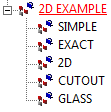Series Beams (3-D SE)
Steel Engineering > New
This HiCAD function enables you to insert beams of user-defined series.
A series beam can be derived from the following:
- a normal 2-D part
(.FIG),
- a 2-D HCM file (.DCF)
or
- a 2-D variant (earlier
HiCAD version, .FIV)
Conventions for
Series Figures
A 2-D series figure can consist of an individual part or an assembly. An assembly can contain both the contours for simple and
exact representation and 2-D elements which you do not want to be included in the beam generation.
It is important that the following rules are observed:
- Elements which
are to be excluded from the creation of the 3-D beam can be grouped in a sub-part
with the name 2-D.
- Notch contours must
be located in a sub-part CUTOUT.
- Points for glass insertion must be defined in a sub-part with the name GLASS.
- If you want to use the contour representation for series beams, a part with the name CONTOUR containing the simplified contour of the complete beam.
- If the 2-D model consists of several main parts, the parts GLASS, CUTOUT,and CONTOUR must not be located on the same level as the parts SIMPLE and EXACT, but on the same level as the the main parts.
- Assign to the sub-parts EXACT and SIMPLE a material and, if required, further attributes. Set the BOM-relevance to YES. These settings, as well as the colour and the line types, will be applied when the 3-D Steel Engineering beam is created. A material should be assigned to the part in any case. The BOM-relevance is particularly important, as only a BOM-relevant series beam will actually appear in the BOM and will be automatically itemised. The easiest way to assign these properties is to choose Steel Engineering > Further functions > Settings
 > Series cross-section - Assign attributes.
> Series cross-section - Assign attributes.
- The centroid of the 2-D part should be located in the absolute zero point. There, the centroidal axis will appear later.
 Important:
Important:
In practice, individual beams in series beam groups can consist of several different cross sections.These can also have different materials, which means that they must be hatched correctly in sectional views. In BOMs and in workshop drawings, however, such beams are always interpreted as 1 part. Therefore, HiCAD also supports series beam groups with individual beams consisting of several, BOM-irrelevant cross-sections. The image below shows an example:

 Please note:
Please note:
- If the 2-D series figure contains the sub-parts EXACT and SIMPLE, a feature recalculation will be performed when you switch between simple and exact representation for the corresponding 3-D series beam. If the 2-D series figure contains the sub-part CONTOUR, the view list will be changed if the corresponding 3-D series beam is e displayed in contour representation, i.e. the part CONTOUR will be shown, and the other representation will be hidden.
- To process a series
beam, you must identify the entire beam. The following options are available
for this:
- choosing the Select beam main part function from the context menu for beams (RMB on Beam), or
- selecting the series
beam via the beam axis, or
- activating the
Group snap identification mode in the transparent toolbar. The group snap mode is active if the
 symbol is displayed on the transparent toolbar. To switch to group snap, multiple clicking of the icon may be required.
symbol is displayed on the transparent toolbar. To switch to group snap, multiple clicking of the icon may be required.

- For series beams you can specify in the Configuration Editor at Steel Engineering > Representation > Representation of series beams whether the edge colour should be determined by the edge colour of the figure or by the default edge colour of the drawing. The default setting is Take colour from figure
 .
.


Fitting
Options for Beams (3-D SE) • Insert Beams
(3-D SE) • Steel Engineering
Functions • Series Cross-Sections
|
© Copyright 1994-2018, ISD Software und Systeme GmbH
Version 2302 - HiCAD Steel Engineering
Date: 28/09/2018
|
> Feedback on this topic
|

 > Series cross-section - Assign attributes.
> Series cross-section - Assign attributes.  Important:
Important: 
![]() Please note:
Please note: symbol is displayed on the transparent toolbar. To switch to group snap, multiple clicking of the icon may be required.
symbol is displayed on the transparent toolbar. To switch to group snap, multiple clicking of the icon may be required. 
 .
. 